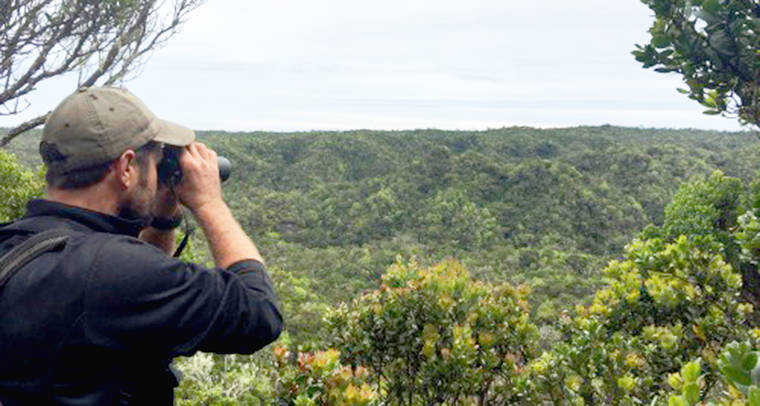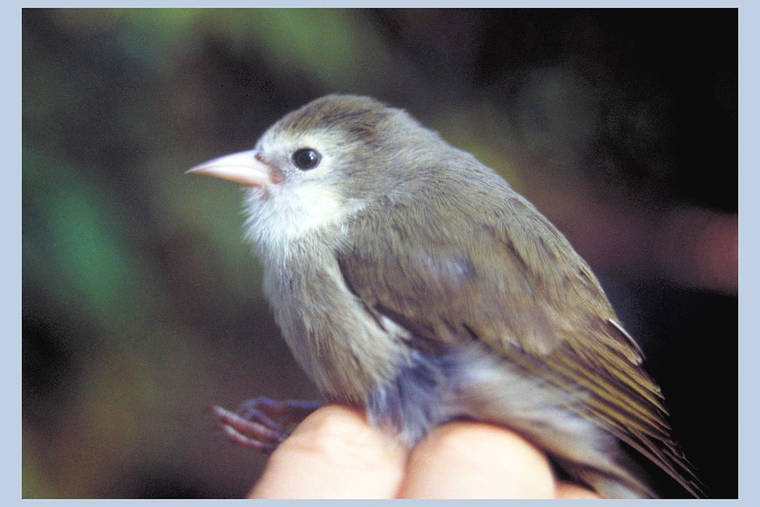KOKEE — Hiking through the sheer ridges and native forests of the world’s highest wetland, Justin Hite spends his time looking and listening for Kauai’s endangered forest birds.
He’s part of U.S. Fish and Wildlife Service’s, “Saving the ‘Akikiki from Extinction Team,” focused on saving one of the most rare birds in the world.
There’s only about 500 ‘Akikiki left in the wild and in order to boost numbers, the team has been collecting eggs from wild nests since 2015 to establish a conservation breeding program.
Their work has led to raising 45 of the tiny, grey- colored forest birds, now living at the San Diego Zoo. It’s also garnered the USFWS’s 2018 Recovery Champion Award.
Teammate Lisa “Cali” Crampton, who works with Hite in the Kauai Forest Bird Recovery Project, says the biggest gain from the award is to be had for the birds themselves.
“It’s more publicity for this critically endangered species,” Crampton said. “To do a job really well and be recognized nationally gives people the confidence to support (conservation of the birds).”
A total of 10 team members received the award for their work in the ‘Akikiki egg collection and conservation breeding project, one which required the use of helicopters, dragging ladders through dense forest, and dealing with severe weather.
In the midst of all of that, they had to locate the tiny eggs in their nests and strategically collect and preserve the eggs on the journey down the mountain.
The team is no longer collecting eggs since they have established a successful conservation breeding population.
“Our effort has shifted to monitoring the remaining birds in the wild, and seeing how the population changes,” Crampton said.
Not much data exists on Kauai’s rarest bird species. In fact the egg collection project allowed for a much greater understanding of the wild adult members of the species. One of the ways that happened was through necessity — the team had to fix brightly colored bands on pairs of ‘Akikiki so they could chose nests from which to take eggs.
“Because of that, we’ve gotten to know a number of them,” Hite said.
Crampton added: “It’s the first time we’ve had that many individually identifiable birds to study and track. You actually get to know about the wild population, too.”
The team has spent so much time studying the ‘Akikiki that they’ve developed nicknames for some of them.
And while they’ve been boosting the conservation breeding population at the San Diego Zoo, they’ve been noticing a decline in those individuals in the wild — especially within the past year.
“Things are maybe not doing so well for them in the wild,” Hite said. “A large number of the birds we know very well and have nicknames for are missing. This year’s still super preliminary, but there’s been a huge number of these breeding birds that are no longer there.”
It could be a natural fluctuation of the species, the team doesn’t have enough information to know for sure, but the observations line up with published numbers in 2016 that showed the ‘akikiki in decline.
As they try to better understand the ‘Akikiki and threats to its survival, team members also work toward re-introducing members of the conservation breeding population back into the wild and eventually bolstering the numbers of the rarest forest bird on Kauai.
Other members of the team include Michelle Clark, Bryce Masuda, Jeremy Hodges and Angie Ray with San Diego Zoo Global, Amy Klotz, formerly of San Diego Zoo Global, and USFWS’s John Vetter and Jay Nelson.
•••
Jessica Else, environment reporter, can be reached at 245-0452 or at jelse@thegardenisland.com




